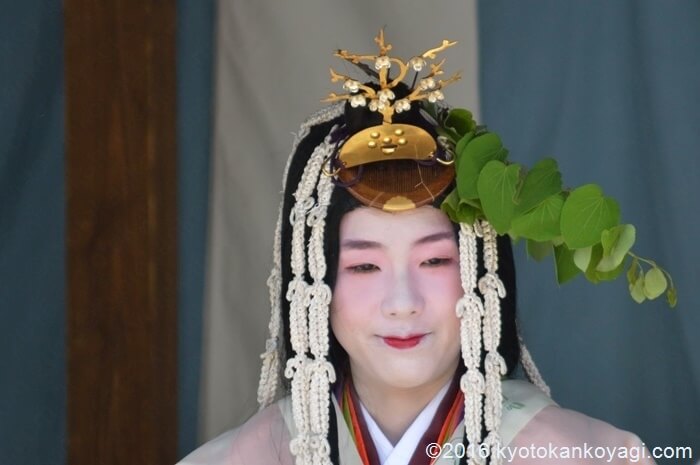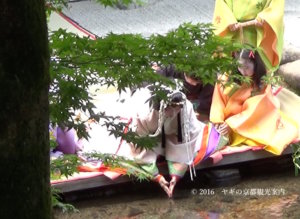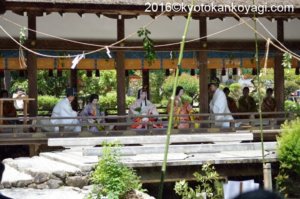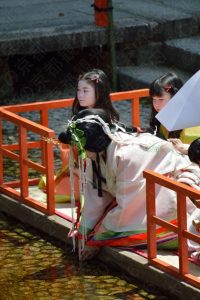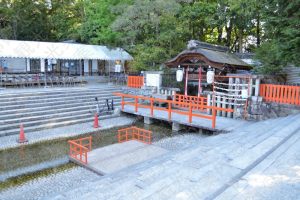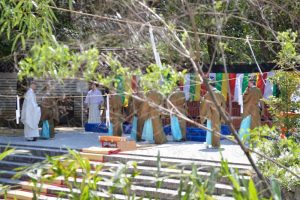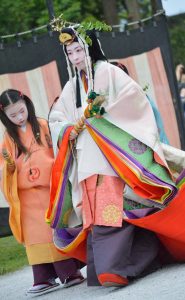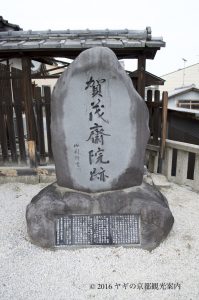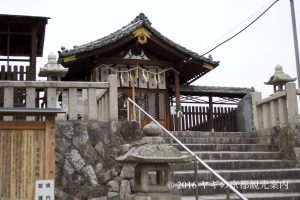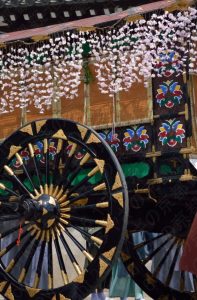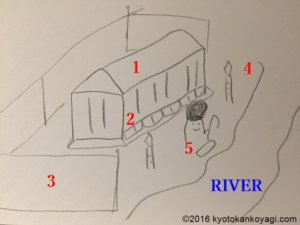Overview 斎王代御禊の儀 概観
What is Gyokei no Gi?
Saiohdai Gyokei no Gi (斎王代御禊の儀) is a ritual held on 4th of May, prior to Aoi matsuri festival. In this ritual, “Saiohdai” purifies herself at a stream of Kamigamo shrine or Shimogamo shrine in every other year. In 2024/ Reiwa 6, it will be held at Shimogamo shrine.
Who is Saiohdai?
Saiohdai (斎王代) means that a substitute of Saioh. Saioh is a priestess served for Aoi matsuri festival in ancietn times. She was chosen in the royal family (mostly a daughter of the emperor) usually. Today, we don’t have the priestess. On the other hand, a lady plays a role of Saioh in Aoi matsuri fesitival and the other rituals belong to it. We discuss about her later in historical point of view.
The video of Saioh da Gyokei no gi
Before making an inspection of the ritual, enjoy Goyokei no Gi.
Gyokei no Gi at Kamigamo shrine 御禊の儀於上賀茂神社
Along the video we saw, let us make sure what Gyokei no Gi is.
The stream in front of Saiohdai is the Nara no Ogawa. There are streams called Omonoigawa and Mitarashi gawa in Kamigamo shrine.
In Japan, we think water purify something evil. These stream go around the main hall of the shrine to tell the border of the sacred and the secular world. They get together and make Nara no Ogawa. So, the stream is also sacred. So, Saohdai make herself purified herself, touching the water of the stream. At Gyokei no Gi, only Saiohdai does this though many ladies participate in the ritual.
On the same reason, rituals to make attendants purified take place in front of the stream and a building called Tsuchinoya, located by it.
After that, all the ladies move to a bridge called Hashidono. On it, they put evil things inside of them on a human-shaped object called Katashiro. The Katashiro for Saiohdai is made of wood though the others are made of paper.
Gyokei no Gi at Shimogamo shrine 御禊の儀於下鴨神社
At Shimogamo shrine, Gyokei no gi is held at Mitarashi ike, a small stream in front of Inoue sha, the sub-shrine of Shimogamo shrine.
You see a white tent. There are seats of relatives of Saiohdai under it. The place where red corns located is for press.
For us, there is a small room left to see the ritual. The ritual starts at 10 a.m. and she touches the stream around 11 a.m.
After the ritual, they move to Shinpukuden to have a photo session.
Saiou-dai in Aoi matsuri festival in historical point of view
Who is Saioh?
Saioh-dai is a most famous lady in Aoi matsuri festival (The lady in the picture above.). The word “dai” means a substitute for someone/something in Japanese. So let me tell you about “Saioh”.
Saioh is a Shinto priestess works as a deputy of the emperor. In the Heian period, when the new emperor was enthroned, a fortune-teller chose Saiou among unmarried ladies in the imperial family on a special fortune-telling.
Once a lady was elected as Saioh, she moved to a small palace called “Hatsu sai in” to purify herself for three years. After the purification of three years, she moved to a small palace temporary built for Saiou called “Nomiya” and purified herself at the river Kamo. After these purification, she was in a state to serve as a deputy of the emperor.
Saiou became extinct in Kamakura period (1185–1333) and was restored as “Saiou-dai” We call her “Saiou-dai” i.e. the substitute for Saiou because she was not erected among the members of the royal family nor is Shinto priestess.
Nomiya or Murasakino Saiin 紫野斎院
Nomiya is build each time Saioh was chosen by Onmyoji, a fortune-teller belonged to the Imperial court. It is believed that Ichiidani Nanano shrine is a debris of one of them which stands the test of time.
Goyokei of Saioh in The Tale of Genji
If you were interested in Japanese culture or literature, you might know The Tale of Genji written by Murasaki Shikibu. In the chapter ‘Aoi’, you can find a incident called “Kuruma arasoi”. That is a small conflict took place at Aoi matsuri festival.
In ancient times, Saioh departs Saiin (the red Torii in the map) heading for south. On Ichijoohji street, she met Chokushi, the messenger of the emperor, and his colleagues (the red alien). They joined together to go to the river Kamo.
The blue alien indicates the supposed place where Gyokei took place. It is “supposed” because the palce was chosen by Onmyoji each time and Gokei was carried out in many places along the river.
People only see Saioh when she was on the way of Gyokei.
How was Gyokei carried on?
The Nenjyu Gyoji Emaki, the guide book of the rituals in Heian period, tells us the ritual.
Around the river Kamo (RIVER in the photo), walls of cloth (3) were made. Inside of the wall, there was a tent (1). (2) is a train of outfit for court ladies. (4) is a torch. It indicates the ritual was held at twilight or night. (5) is a priest.
How to get to Shimogamo shrine?
From JR kyoto station
Take Kyoto city bus no.4 and get off at Shimogamo Jinjamae bus stop.
About Shimogamo shrine

